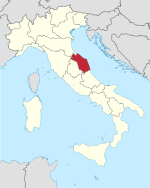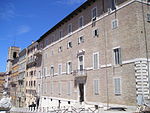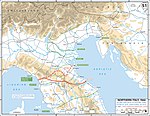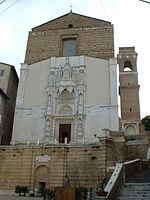Ancona
380s BC establishmentsAnconaCities and towns in the MarcheCoastal towns in the MarcheDuchy of the Pentapolis ... and 8 more
Mediterranean port cities and towns in ItalyMunicipalities of the Province of AnconaPages including recorded pronunciationsPages with Italian IPAPapal StatesPopulated places established in the 4th century BCPort cities and towns of the Adriatic SeaSyracusian colonies

Ancona (, also US: , Italian: [aŋˈkoːna] ) is a city and a seaport in the Marche region of Central Italy, with a population of around 101,997 as of 2015. Ancona is the capital of the province of Ancona and of the region. The city is located 280 km (170 mi) northeast of Rome, on the Adriatic Sea, between the slopes of the two extremities of the promontory of Monte Conero, Monte Astagno and Monte Guasco. Ancona is one of the main ports on the Adriatic Sea, especially for passenger traffic, and is the main economic and demographic centre of the region.
Excerpt from the Wikipedia article Ancona (License: CC BY-SA 3.0, Authors, Images).Ancona
Piazza Camillo Benso Conte di Cavour, Ancona
Geographical coordinates (GPS) Address Nearby Places Show on map
Geographical coordinates (GPS)
| Latitude | Longitude |
|---|---|
| N 43.616944444444 ° | E 13.516666666667 ° |
Address
Piazza Camillo Benso Conte di Cavour (Piazza Cavour;Piazza Camillo Benso Cavour;Piazza Camillo Benso di Cavour)
Piazza Camillo Benso Conte di Cavour
Ancona
Marche, Italy
Open on Google Maps










